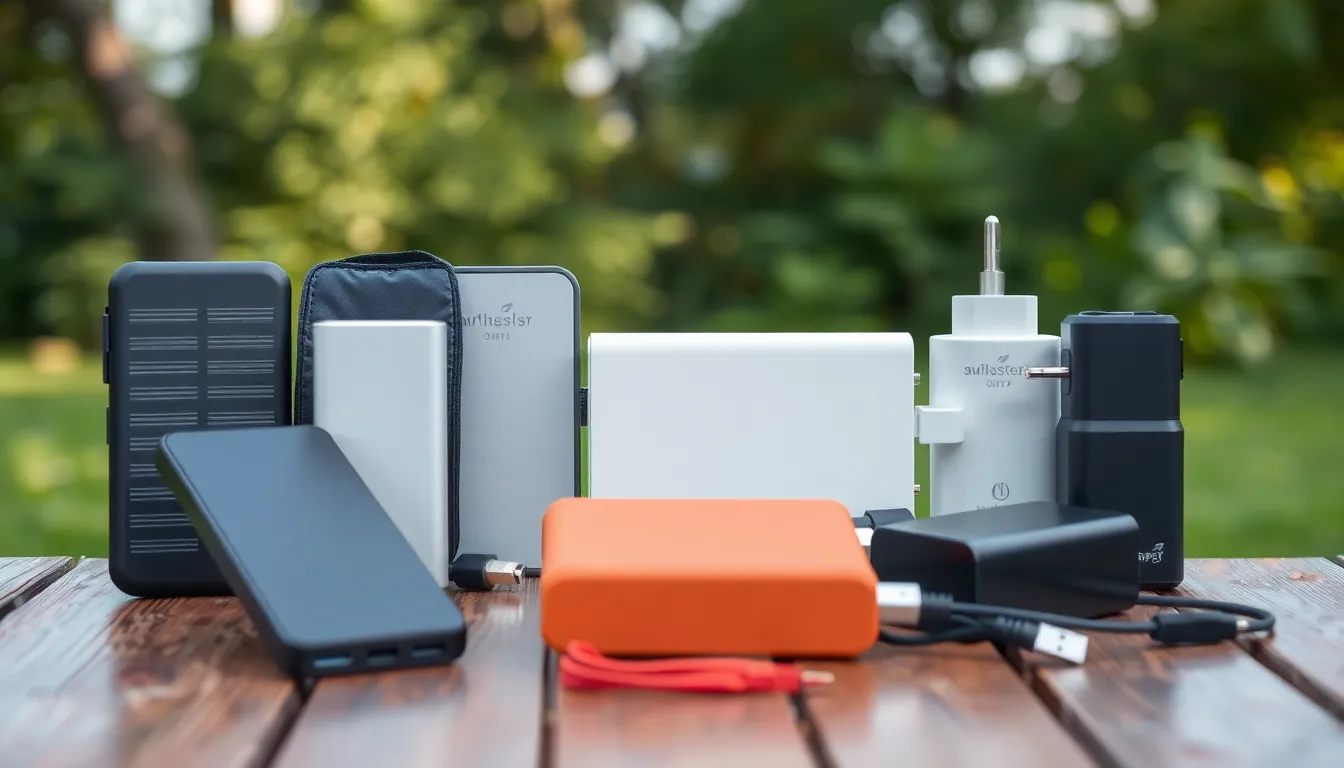In a world where smartphones have become lifelines, running out of battery can feel like a mini apocalypse. Picture this: you’re out and about, phone at 2% and your favorite meme just dropped. Enter the portable charger, the unsung hero of modern life. It’s like having a tiny power plant in your bag, ready to save the day when your device decides to throw in the towel.
Table of Contents
ToggleWhat Is a Portable Charger?
A portable charger is a compact device designed to recharge various electronics while on the go. Typically including features such as USB ports, these chargers accommodate smartphones, tablets, and other gadgets. Most portable chargers harness lithium-ion battery technology, offering significant energy storage in a small form factor.
They are recognized for convenience, especially for individuals who rely heavily on mobile devices. Many users experience anxiety about battery life, making portable chargers essential for uninterrupted access to digital content. When a smartphone battery drains, portable chargers can restore power efficiently, ensuring communication remains seamless.
Numerous types exist in the market, reflecting varying capacities and designs. Some portable chargers support fast charging, which significantly reduces downtime. Additionally, options like solar-powered chargers provide alternatives for outdoor enthusiasts.
Considering capacity, chargers range from 2,000 mAh to over 20,000 mAh. A 10,000 mAh charger can recharge most smartphones two to three times. Weighing as little as 4 ounces, many models offer portability without compromising performance.
Features like built-in cables and multiple outputs enhance usability. High-quality portable chargers also ensure safety through integrated protection against overcharging and short circuits. As users prioritize efficiency, selecting a reliable portable charger becomes key to maintaining device functionality in various scenarios.
Types of Portable Chargers
Various types of portable chargers cater to different needs, offering diverse functionalities and capacities. Each type plays a specific role in providing energy on the go.
USB Power Banks
USB power banks rank among the most common types of portable chargers. Most of these chargers feature multiple USB ports, allowing simultaneous charging of multiple devices. Capacities usually range from 2,000 mAh to 20,000 mAh, making them suitable for phones, tablets, and other small electronics. Fast-charging capabilities enhance efficiency, enabling quick boosts to battery levels. A typical power bank weighs around 4 ounces, offering portability without sacrificing power. Users appreciate the convenience of built-in cables in some models, eliminating the need for extra accessories.
Solar Portable Chargers
Solar portable chargers harness solar energy to charge devices, providing a sustainable option. They incorporate solar panels that capture sunlight and convert it into electrical energy. Often used during outdoor activities, these chargers excel at providing power in remote locations. Some models come with built-in batteries, storing energy for later use. Capacities can range from 5,000 mAh to 10,000 mAh. Users should position these chargers in direct sunlight for optimal charging efficiency. Featuring rugged designs, many solar chargers also withstand various weather conditions, increasing their longevity.
AC Portable Chargers
AC portable chargers deliver power similar to traditional wall outlets, making them versatile for larger devices. Many models include AC outlets and multiple USB ports for charging numerous gadgets simultaneously. These chargers often feature higher capacities, typically exceeding 20,000 mAh, suitable for laptops and advanced electronics. Portability remains a key selling point, with some weighing only a few pounds. Users can find models equipped with safety features, including surge protection and short circuit safeguards. Ideal for travel or emergencies, they serve as reliable backup power sources.
Key Features to Consider
Selecting a portable charger involves evaluating several key features that impact performance and usability.
Capacity and Power Output
Capacity significantly influences a portable charger’s effectiveness. Ranging from 2,000 mAh to over 20,000 mAh, higher capacities provide more charges for devices. Power output, measured in watts, determines how quickly devices can recharge. Chargers offering at least 10 watts are suitable for smartphones. For larger devices, like tablets or laptops, look for chargers with 20 watts or more. Prioritizing capacity and power output ensures users can meet their charging needs, especially during extended outings.
Size and Weight
Size and weight contribute to portability and convenience. Lightweight models can weigh as little as 4 ounces, making them easily portable in bags or pockets. Compact designs fit well in small spaces, providing flexibility for mobile users. However, larger chargers with high capacity may weigh more but offer greater energy storage. Opting for a balance between size and weight enhances user experience, especially for those frequently on the move.
Charging Speed
Charging speed defines how fast devices regain battery life. Fast-charging technology, often found in portable chargers, allows for quicker power delivery. Look for chargers with Quick Charge or USB Power Delivery features for the best performance. These technologies can recharge compatible devices up to 75% faster compared to standard chargers. Ensuring a swift charge improves usability, especially when time is limited or when multiple devices require power simultaneously.
Top Portable Chargers on the Market
Portable chargers offer various options that cater to different user needs. Below are some of the best portable chargers available today.
Best for Budget
The Anker PowerCore 10000 stands out as an affordable choice for users seeking reliability without breaking the bank. Its compact design fits easily in pockets or bags. With a capacity of 10,000 mAh, it provides multiple charges for most smartphones. Users enjoy fast charging through its PowerIQ technology, which adapts to each device’s needs. Priced around $25, it combines quality and budget-friendliness. This charger also includes safety features against overheating and overcharging, ensuring peace of mind during use.
Best for High Capacity
For those requiring substantial power, the RAVPower 20000 mAh Portable Charger excels in delivering high capacity. This model supports charging multiple devices simultaneously via three USB ports. It boasts a robust output of 24 watts, allowing phones and tablets to recharge quickly. Users benefit from a high capacity that can charge an iPhone 8 up to seven times. At approximately $50, it strikes a balance between performance and price. RAVPower also ensures safety with built-in protections, making it an excellent choice for heavy users.
Best for Travel
The Zendure A2 Portable Charger ranks as top travel-friendly power bank due to its ultra-durable design. Fitting comfortably in small bags, it weighs only 10.6 ounces and offers a 6,700 mAh capacity. This charger can efficiently recharge smartphones multiple times. With its 2.4A output, it quickly powers devices while on the go. Priced around $40, it remains an excellent investment for frequent travelers. Users appreciate its rugged exterior that withstands drops and impacts, ensuring long-lasting performance during adventures.
Conclusion
Portable chargers have become indispensable in a world where staying connected is vital. They offer a practical solution to battery anxiety and ensure users can access their devices without interruption. With a variety of options available, including fast-charging and solar-powered models, there’s a portable charger to fit every lifestyle.
When choosing a charger, considering capacity, size, and charging speed is essential to meet individual needs. Investing in a reliable portable charger not only enhances convenience but also provides peace of mind during daily activities or travel. As technology continues to evolve, these compact power sources will remain key players in maintaining device functionality on the go.





